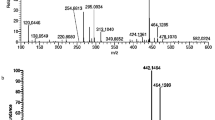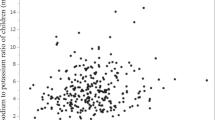Abstract
Background/Objective:
To develop a salt fortified with multiple micronutrients, to test its stability during storage and cooking, and to assess its efficacy in improving the micronutrient status and the health of schoolchildren.
Subject/Methods:
A salt fortified with multiple micronutrients was developed containing chelated ferrous sulfate and microencapsulated vitamins A, B1, B2, B6, B12, folic acid, niacin, calcium pantothenate and iodine. Its stability during 20 min of cooking and 6 months of storage was determined. Thereafter, the efficacy of the salt was assessed in 5- to 15-year-old schoolchildren in Chennai, India. For the experimental group (N=119), the food in the school kitchen was cooked with fortified salt for a period of 1 year. The control group (N=126) consisted of day scholars who did not eat at the school. Hemoglobin, red blood cell count, hematocrit, serum vitamin A and urinary iodine were measured at baseline and at the end of the study after 1 year.
Results:
All micronutrients were stable during cooking and storage. Over the study period, there was a significant improvement (P<0.05) in hemoglobin, red cell count, urinary iodine and serum vitamin A in the experimental group, while there was a significant drop (P<0.05) in hemoglobin, hematocrit, red cell count and urinary iodine in the control group. In the experimental group, there was a mean increase of 0.55 g/dl in hemoglobin, 0.001 l/l in hematocrit, 0.470 million/mm3 in red cell count, 212 μg/l in urinary iodine and 5.6 μg/dl in serum vitamin A.
Conclusion:
The study shows that the salt fortified with multiple micronutrients is stable during cooking and storage and effective in combating multiple micronutrient deficiencies.
This is a preview of subscription content, access via your institution
Access options
Subscribe to this journal
Receive 12 print issues and online access
$259.00 per year
only $21.58 per issue
Buy this article
- Purchase on Springer Link
- Instant access to full article PDF
Prices may be subject to local taxes which are calculated during checkout
Similar content being viewed by others
References
Allen LH, Rosado JL, Casterline JE, Lopez P, Munoz E, Garcia OP et al. (2000). Lack of hemoglobin response to iron supplementation in anemic mexican preschoolers with multiple micronutrient deficiencies. Am J Clin Nutr 71, 1485–1494.
Allen LH (1994). Nutritional influences on linear growth: a general review. Eur J Clin Nutr 48 (Suppl 1), S75–S89.
Bamji MS, Sarma KV, Radhiah G (1979). Relationship between biochemical and clinical indices of B vitamin deficiency. A study in rural school boys. Br J Nutr 41, 431–441.
Blanck HM, Bowman BA, Serdula MK, Khan LK, Kohn W, Woodruff BA (2002). Angular stomatitis and riboflavin status among adolescent Bhutanese refugees living in Southeastern Nepal. Am J Clin Nutr 76, 430–435.
Dacie JV, Lewis SM (1995). Practical Haematology 8th edn. Churchill Livingstone: Edinburgh.
Indian Pharmacopoeia (1996) Published by Publication and Information Directorate, Council for Scientific and Industrial Research (CSIR), Ministry of Health and Family Welfare, Government of India.
Jayaraman J (1996). Laboratory Manual in Biochemistry. Wiley Eastern Ltd: New York.
Nair KM, Brahmam GNV, Ranganathan S, Vijayaraghavan K, Sivakumar B, Krishnaswamy K (1998). Impact evaluation of iron and iodine fortified salt. Indian J Med Res 108, 203–211.
Mannar MGV, Diosady LL (1998). Double fortification of salt with iron and iodine. In: The Micronutrient Initiative (ed). Food Fortification to End Micronutrient Malnutrition. The Micronutrient Initiative: Ottawa. pp 89–94.
Olsen A, Thiong'o FW, Ouma JH, Mwaniki D, Magnussen P, Michaelsen KF et al. (2003). Effects of multimicronutrient supplementation on helminth reinfection: a randomized, controlled trial in Kenyan schoolchildren. Trans R Soc Trop Med Hyg 97, 109–114.
Pino S, Fang SL, Braverman LE (1996). Ammonium persulphate: a safe alternative oxidizing reagent for measuring urinary iodine. Clin Chem 42: 2, 239–243.
Rajagopalan S, Vinodkumar M. (2000). Effect of salt fortified with iron and iodine on hemoglobin levels and productivity of tea pickers. Food Nutr Bull 21, 323–329.
Rivera JA, Gonzalez-Cossio T, Flores M, Romero M, Rivera M, Tellez-Rojo MM et al. (2001). Multiple micronutrient supplementation increases the growth of Mexican infants. Am J Clin Nutr 74, 657–663.
Sivakumar B, Brahmam GNV, Niar KM, Ranganathan S, Vishnuvardhan Rao M, Vijayaraghavan K et al. (2001). Prospects of fortification of salt with iron and iodine. Br J Nutr 85, 167–173.
Skikne B, Baynes RD. (1993). Iron absorbtion. In: Brock JH, Halliday JW, Pippard MJ, Powell LW (eds). Iron Metabolism in Health and Disease. Saunders: London. pp 152–187.
Taylor M, Jinabhai CC, Couper I, Kleinschmidt I, Jogessar VB (2001). The effect of different anthelmintic treatment regimens combined with iron supplementation on the nutritional status of schoolchildren in KwaZulu-Natal, South Africa: a randomized controlled trial. Trans R Soc Trop Med Hyg 95, 211–216.
UNICEF/UNU/WHO/MI (1999). Preventing Iron Deficiency in Women and Children Technical Consensus on Key Issues 1999 International Nutrition Foundation: New York, NY.
United Nations Children's Fund (2000). The State of the World's Children 2000. UNICEF: New York, NY.
Wegmuller R, Zimmermann MB, Hurrell RF (2003). Dual fortification of salt with iodine and encapsulated iron compounds: stability and acceptability testing in Morocco and Cote Ivoire. J Food Sci 68, 2129–2135.
World Health Organization (2000). Malnutrition. The Global Picture 2000. WHO: Geneva, Switzerland.
Yang YX, Han JH, Shao XP, He M, Bian LH, Wang Z et al. (2002). Effect of micronutrient supplementation on the growth of preschool children in China. Biomed Environ Sci 15, 196–202.
Zimmermann MB, Wegmueller R, Zeder C, Chaouki N, Rohner F, Saissi M et al. (2004). Dual fortification of salt with iodine and micronised ferric pyrophosphate, a randomized double blind controlled trial. Am J Clin Nutr 80, 952–959.
Zimmermann MB, Zeder C, Chaouki N, Saad A, Torrensoni T, Hurrell RF (2003). Dual fortification of salt with iodine and microencapsulated iron: a randomized double blind controlled trial in Morrocan school children. Am J Clin Nutr 77, 425–432.
Acknowledgements
We acknowledge the Sundar Serendipity Foundation for funding the study and Professor MS Swaminathan, Chairman of the MS Swaminathan Research Foundation, who guided us throughout the study. This work was financially supported by Sundar Serendipity Foundation, Chennai.
Author information
Authors and Affiliations
Corresponding author
Rights and permissions
About this article
Cite this article
Vinodkumar, M., Rajagopalan, S. Multiple micronutrient fortification of salt. Eur J Clin Nutr 63, 437–445 (2009). https://doi.org/10.1038/sj.ejcn.1602955
Received:
Revised:
Accepted:
Published:
Issue Date:
DOI: https://doi.org/10.1038/sj.ejcn.1602955
Keywords
This article is cited by
-
Optimization of the color masking and coating unit operations for microencapsulating ferrous fumarate for double fortification of salt
Journal of Food Science and Technology (2022)
-
Folic acid fortification of double fortified salt
Scientific Reports (2021)



